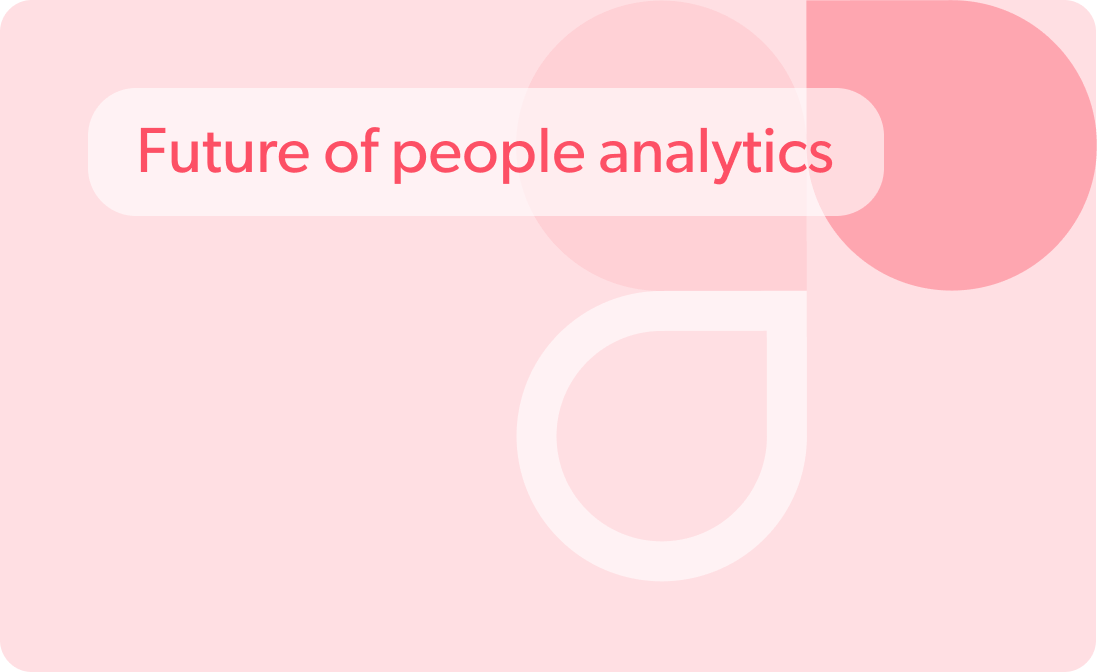The science of HR data storytelling
Numbers don’t lie, but they can deceive
In 2023, we find ourselves amid a digital revolution characterized by the daily generation of an astounding 3.5 quintillion bytes of data – a figure comprising 3.5 followed by an astonishing 18 zeros. The statistic revealing that 70 percent of business leaders contemplating relinquishing their decision-making to robots should be no surprise. With such an overwhelming volume of data available, it can be a daunting task to draw meaningful conclusions.
Let’s take the example of employee turnover. While the prevailing notion suggests that higher pay leads to longer employee retention, this perspective contradicts the findings published by HBR. According to the Harvard Business Review, 9 out of 10 people are willing to accept lower salaries for more meaningful work. In this era where numbers seemingly do not lie, it’s crucial to recognize that data can be misleading without adept interpretation. This is where the art of data storytelling emerges as an invaluable guide, bridging the gap between raw data and meaningful insights.
What‘s the HR tale behind data storytelling? Hint: It’s not just about painting the dashboard
In our recent workshop, we explored the vital role of data storytelling in HR, specifically through external market data insights. The workshop featured Florian Fleischmann, managing director of HRForecast, who discussed how data-driven HR strategies, driven by external data, are transforming the HR landscape.
Data storytelling in HR is an essential practice involving the strategic use of internal and external data to construct compelling narratives guiding talent management and HR decisions. It transcends conventional data presentation, transforming raw information into actionable insights through persuasive storytelling. This approach addresses the limitations of relying solely on internal data by incorporating external sources like job postings, offering insights into skills demand and location-specific salary variations. Advanced algorithms help identify emerging job market trends, facilitating data-driven recruitment strategies.
Data storytelling empowers HR with the knowledge to adapt to changing skill requirements and align workforce development with industry trends. Ultimately, it ensures HR decisions are rooted in comprehensive data and meaningful narratives for a competitive edge in talent management.
So, is your data storytelling a masterpiece or a mess?
In the compelling contest of narratives, the emphasis extends beyond mere data to the art of narrative delivery. To exemplify the considerable impact of data storytelling, consider an organization’s focus on mitigating employee turnover and promoting elevated employee retention. On one front, a riveting narrative stands as sharp as a blade, while on the other, a convoluted storyline requires a protagonist. This example elucidates how the craft of data storytelling functions as the guiding beacon for the transformation of HR strategies.
Source: HRForecast
10 data storytelling challenges in HR
1) Data quality challenges
Data integrity: Maintaining data integrity ensures accuracy, completeness, and consistency. It’s about entering data correctly and preventing errors, duplications, and inconsistencies across different HR systems and sources. This involves data validation, cleansing, and ongoing monitoring.
Data relevance: In a sea of available data, the challenge is identifying which HR metrics and data are most relevant for effective storytelling. This process requires HR professionals to determine which data points have the most significant impact on their decision-making processes.
2) Data interpretation challenges
Complexity: HR data can be incredibly complex, involving numerous variables, from performance metrics to employee demographics. Extracting meaningful insights from such complexity requires advanced analytical skills. Complex data might include data from multiple sources, structured and unstructured data, and multi-dimensional data, adding layers of complexity to interpretation.
Bias: Bias can creep into HR data at various stages, from data collection to analysis. Identifying and addressing these biases is challenging, as it requires domain expertise in HR and the ability to recognize subtle biases that can affect storytelling objectivity.
3) Technical challenges
Data integration: HR systems often comprise multiple components, from HRIS to applicant tracking systems and performance management tools. Integrating data from these various sources is technically complex, and it necessitates the use of integration platforms, APIs, and data transformation processes to ensure that data is consistent and accessible for storytelling.
Data analysis: HR professionals must leverage advanced analytical tools and techniques to derive meaningful insights. This requires expertise in data analytics, statistics, and data modeling. Data analysis also involves dealing with large datasets, which can be technically challenging.
4) Communication and presentation challenges
Data visualization: Visualizing HR data in an accessible and engaging manner for non-technical stakeholders is an art. The challenge here is to present data through effective graphs, charts, and visuals, which convey complex insights intuitively.
Narrative building: Creating a compelling narrative around data is no small task. It requires not only data expertise but also storytelling skills. The challenge is to tell a coherent and engaging story that contextualizes data, making it meaningful and relevant to the audience.
5) Privacy and compliance challenges
Data security: Ensuring data security while using sensitive employee information for storytelling is a paramount challenge. It involves robust data encryption, access control, and compliance with data protection regulations like GDPR.
Compliance: Keeping up with evolving legal and ethical standards related to HR data usage can be challenging. HR departments must stay informed about changing data protection laws and ensure compliance in data usage.
6) Change management challenges
Resistance to change: HR professionals often encounter resistance when transitioning from traditional HR practices to data-driven decision-making. Resistance can stem from employees and even leadership who are comfortable with traditional methods. Overcoming this challenge requires effective change management strategies that involve communication, education, and addressing concerns.
Aligning with organizational goals: Ensuring data storytelling aligns with HR and broader organizational objectives is challenging. Data-driven HR strategies must be effective and seamlessly integrated with the organizational plan. To address this, HR professionals need to align their data storytelling efforts with the organization’s strategic goals, demonstrating how data-driven decisions contribute to achieving those goals.
7) Cultural challenges
Data-driven culture: Fostering a data-driven culture within HR involves changing mindsets and practices. This cultural shift challenges the conventional wisdom that has existed for many years. HR professionals must instill a sense of data literacy, encouraging all HR team members to use data effectively in their decision-making processes. This might involve educational initiatives, mentorship, and leadership that promote data literacy as a core competency.
Overcoming silos: Silos often develop over time, lacking collaboration and communication between HR and other business units. Addressing this challenge requires promoting cross-functional collaboration, possibly restructuring the organization to facilitate information flow, and instilling a mindset of shared responsibility in data utilization.
8) Measurement and ROI challenges
ROI measurement: Quantifying data-driven HR initiatives’ impact and return on investment is complex. Not all outcomes can be directly translated into monetary terms. For example, the impact of employee engagement initiatives may not have a clear financial value. HR professionals must explore ways to measure the effectiveness of initiatives beyond simple financial metrics. This can involve surveying employees, monitoring changes in performance, and assessing qualitative improvements.
Ready to craft a data-driven success story? Let’s turn the page together
From shaping a workforce with the right skills to reducing costs and optimizing efficiency, the ROI calculator helps you tell the story of impactful decisions and returns on investment.
Identifying key metrics: Determining the key performance indicators (KPIs) for HR storytelling is challenging due to the vast array of available metrics. It requires selecting those KPIs that best align with HR and organizational objectives. HR professionals must comprehensively analyze which metrics matter most, considering factors like the specific HR initiative, industry benchmarks, and overall company goals.
9) Data access and availability challenges
Data accessibility: Ensuring that relevant HR data is accessible to authorized personnel while maintaining security and privacy is a delicate balance. Establishing data access policies that grant access to those who need it while preventing unauthorized users from gaining entry is challenging. Data accessibility should also consider data governance principles that define roles and responsibilities.
Real-time data: Timeliness is critical in data availability for HR decisions. Real-time or near-real-time data can significantly impact the effectiveness of HR strategies. Delays in data availability can lead to suboptimal decisions. HR professionals must implement systems and processes that promptly deliver data to meet the needs of the HR department and the organization.
10) Resistance to data-driven decisions
Traditional practices: Overcoming a preference for traditional HR decision-making methods is challenging. Traditional practices often have deep-rooted histories within organizations, and there can be reluctance to shift to data-driven approaches, especially if there’s a belief that “the old way works just fine.” HR professionals must effectively communicate how data-driven methods enhance decision quality and lead to more successful HR outcomes. Demonstrating real-world examples of improved results can be a compelling way to overcome this resistance.
Cultural resistance: Addressing resistance to change among HR staff and leadership is a multifaceted challenge. It involves providing technical training to staff to enhance their data literacy and driving cultural shifts that embrace data-driven practices. HR leadership must lead by example, promote the value of data-driven decisions, and ensure that the entire HR team is on board with this new approach. A cultural shift toward data-driven decision-making can take time but is crucial for successful implementation.
Addressing these challenges requires a holistic approach involving collaboration between HR professionals, data analysts, and IT experts. Building data storytelling capabilities in HR also involves ongoing training, cultural shifts, and a commitment to data-driven decision-making.
Craft tomorrow’s workforce narratives with smartData
In HRForecast, data storytelling is a strategic process empowered by smartData, a vast and dynamic labor market database. It provides HR professionals with an exceptional toolkit for narrating compelling stories using market intelligence. Here’s how data storytelling is executed:
End-to-end workforce planning: HRForecast leverages outside data to help organizations understand current and future workforce needs. This includes identifying current and future roles and skills, competitor benchmarking, location analysis, workforce gaps, and more.
Building HR action plans: By providing actionable insights and strategic HR action plans, HRForecast enables HR professionals to take data-driven decisions to align their workforce with their strategic goals.
Access to real-time market data: smartData offers instant access to a wealth of market data. This includes data on job postings from over 500 million sources, job profiles in multiple languages, skills libraries, and data from 122 countries. This data becomes the foundation for powerful data storytelling.
Use cases: HRForecast presents a variety of use cases, demonstrating how organizations can benefit from smartData. Whether it’s recruiting, learning and development, or talent management, these use cases show how HR professionals can improve their strategies using market insights.
Your value from the approach: The approach of smartData enhances recruiting by helping organizations understand the skills they need to recruit for and reducing time-to-hire. It boosts learning and development by ensuring employees acquire the skills required for the future. Additionally, it aids talent management by providing Big Data evidence to inform talent decisions.
Get in touch with us if you are looking for a comprehensive approach to data storytelling in HR by leveraging external market data, offering real-time insights, and a wealth of data-driven possibilities.
Stay up to date with our newsletter
Every month, we’ll send you a curated newsletter with our updates and the latest industry news.




























 info@hrforecast.de
info@hrforecast.de
 +49 89 215384810
+49 89 215384810






